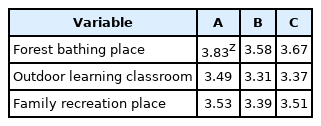Users’ Recognition and Satisfaction of Trails and Exercise Facilities in Urban Mountainous Forests: Focused on Jinju City, South Korea
Article information
Abstract
Background and objective
This study was conducted to analyze users’ behavior, recognition, and satisfaction toward forest trails and exercise facilities in urban mountainous forests, Jinju City, South Korea.
Methods
Users’ characteristics, visit motives, and satisfaction with forest trails and exercise facilities in three urban mountainous forests were surveyed from September to October 2020. The data of 300 respondents were analyzed using frequency, descriptive, and regression analysis.
Results
There was a high percentage of users aged 51 or older (62.0%). Most users visited regardless of weekdays or weekends, every day or 2–3 times a week, and stayed for 1–2 hours. Most were using the forest trails and outdoor fitness facilities. Hiking or walking showed the highest frequency in visit motives, followed by using outdoor fitness facilities. Overall satisfaction with forest trails was high at 3.74–3.93 on a 5-point Likert scale, which was affected by the landscape and environment of small private arable lands around forest trails and convenient facilities such as handrails and information boards. Overall satisfaction with outdoor fitness facilities was 3.34–3.62, which was affected by harmony with forest landscape and facility maintenance. Overall satisfaction with indoor badminton courts was 3.01–3.08, which was affected by harmony with forest landscape.
Conclusion
For improving overall satisfaction, it is crucial to maintain and repair the width and surface of forest trails, but renovating the landscape and environment of small private arable lands and exercise facilities may be more critical. It is desirable to improve and maintain the function and landscape of outdoor fitness facilities and to relocate indoor badminton courts to the outskirts or boundaries of the mountainous forests. To provide various leisure and recreation activities, the creation of a forest bathing place will be first necessary, followed by a family recreation place and outdoor learning classroom.
Introduction
Leisure and recreational activities for health, rest, and entertainment are increasing, and there are diverse needs for places, facilities, and programs for this purpose (Heo et al., 2017). Exercise is especially an important leisure activity on both weekdays and weekends (Lee and Yun, 2009), and with the revitalization of sports for all played voluntarily to promote health and fitness as well as leisure, exercise facilities such as outdoor fitness facilities and indoor badminton courts have been installed around forest trails in urban mountainous forests as well as urban parks nationwide (Cho, 2021; Jeong, 2016; Lee and Kim, 2018). Mountainous districts, which take up 64% of South Korean territory, are land resources that are the basis of national life and economic activities, as well as environmental resources that constitute natural landscapes (Jung and Jeong, 2018), and they have been also actively used as recreational resources in addition to producing forest products (Park, 2002). Most cities in South Korea have mountainous forests, and they are rich in natural resources compared to urban parks, satisfying the needs of citizens with high natural experiences and health needs, accessibility, and providing linkage with other landscape elements as an important element constituting the landscape (Shin et al., 2010). Therefore, conserving and managing nature, landscape and ecology in mountainous forests is an important policy task in terms of improving the quality of citizens’ life.
Recreational activities in the forest were limited during the 1st National Forest Plan (1973–1982) because reforestation was the policy goal. But policies during the 4th National Forest Plan (1998–2007) and 5th National Forest Plan (2008–2017) were for quantitative increase of leisure sports in the forest due to the increasing demands. The 6th National Forest Plan (2018–2037) plans to improve the quality of leisure sports in the forest, such as tourism, industrialization, facility registration system, and safety improvement (Lee and Kim, 2018). The purpose of visiting urban mountainous forests was mostly to work out or take walks for health (Heo et al., 2016; Heo et al., 2017; Yoo et al., 2007). Lee and Kim (2018) perceived exercise facilities and forest trails as major forest welfare facilities. Meanwhile, natural landscapes were destroyed and disasters were caused by indiscreet development or damage to mountainous forests. Accordingly, the Mountainous Districts Management Act was established in 2003 to prevent sprawling of mountainous districts and comprehensively and systematically manage these districts, but the criteria for permission for conversion of mountainous districts are prescribed and managed by the ordinance of each local government (Jung and Jeong, 2018).
Urban mountainous forests in South Korea have been damaged by ruthless exploitation or have a high potential risk due to citizens’ demand for expansion of exercise facilities, high population density, and relatively insufficient space for urban parks and exercise facilities (Yoo et al., 2007). Jinju City (Gyeongnam) has been establishing plans to create amenities and exercise facilities for hiking trails in urban mountainous forests based on the standards set by the “Manual for Establishment, Operation, and Management of Forest Trails”, “Hiking Trail Maintenance Manual”, and the Forestry Culture and Recreation Act. In addition to the maintenance of existing forest trails in urban mountainous forests, such as the installation of wooden stairs and decks as well as coconut mats, small exercise areas with exercise facilities have also been established and maintained (Heo et al., 2017). In the process, complaints have been recently raised about inappropriate facilities built around forest trails. Urban mountainous forests are places of leisure and recreation among urban residents with landscape and natural resources, and dynamic and static uses have been constantly increasing. Along with that, damage to the forest landscape and natural resources is also increasing, which may consequently lower the satisfaction of visitors. Thus, it is necessary to understand the user characteristics and recognition of forest trails and exercise facilities in urban mountainous forests. Therefore, this study seeks effective ways to develop and manage urban mountainous forests by evaluating user behavior, recognition, and satisfaction of forest trails and exercise facilities (outdoor fitness facilities and indoor badminton courts) in urban mountainous forests of Jinju City, South Korea.
Research Methods
Site and spatial extent
Jinju City has an area of 712.86 km2 and a population of 352,000 (Jinju City, 2022). It is a city of history, culture, art, and education, the center the southern region with natural landscape and efficient urban infrastructure, and a tourist hub connecting Jinjuseong Fortress, Jinyangho Lake, Mt. Jirisan, and Hallyeohaesang National Park. The study sites are Mt. Seonhaksan (135.5 m), Mt. Sukhosan (137.5 m), and Mt. Seokgapsan (153.0 m) located in areas where 79 .5% of the population in J inju City live, and the spatial scope is limited to forest trails and exercise facilities (Figs. 1 and 2). The sites are mountainous forests surrounding the center of the city, located adjacent to residential and commercial areas, and the basic status is as shown in Table 1. Jinju City has installed wooden steps on steep forest trails and have coconut mats laid out on the surface of heavily eroded forest trails. Exercise facilities were classified into outdoor fitness facilities and indoor badminton courts. First, outdoor fitness facilities are established next to forest trails, inside forest trails, and at outdoor fitness places. There are 2–3 exercise facilities next to forest trails, approximately 5 in forest trails, and approximately 10 in outdoor fitness places. There is one indoor badminton court each next to the outdoor fitness place that was built in 2011. There are 88, 56, and 100 members of the indoor badminton court in Mt. Seonhaksan, Mt. Sukhosan, and Mt. Seokgapsan, respectively. There are total 36 badminton clubs in Jinju City, and 2,035 members are officially registered in Badminton Korea Association. However, there are unofficial clubs and members using illegal temporary buildings made of steel frames and tents as indoor badminton court in Mt. Seonhaksan, Mt. Sukhosan, and Mt. Seokgapsan. This phenomenon is found similarly in many other cities and counties.
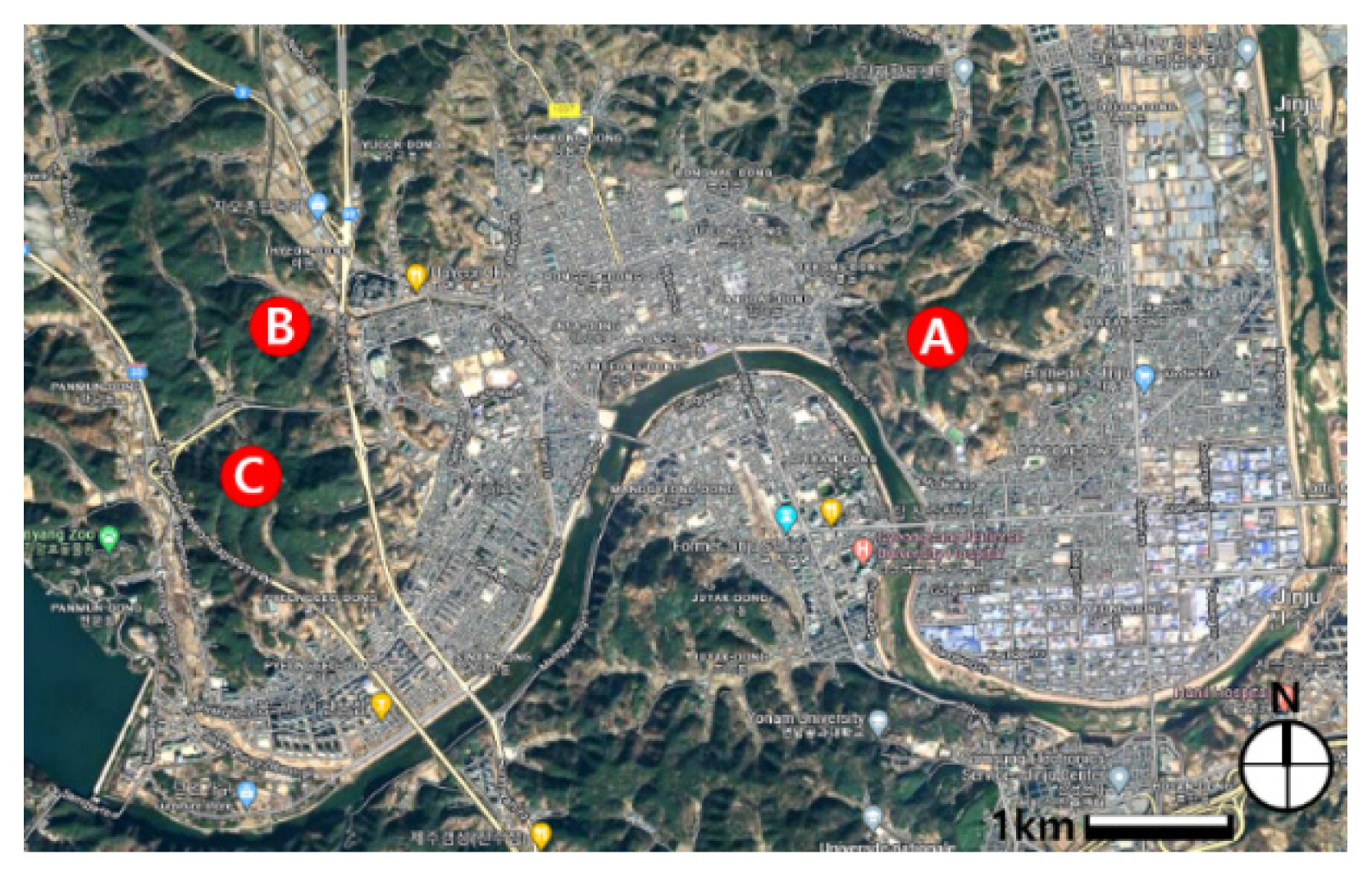
Location and status of Mt. Seonhaksan (A), Mt. Sukhosan (B), and Mt. Seokgapsan (C), Jinju City, South Korea.
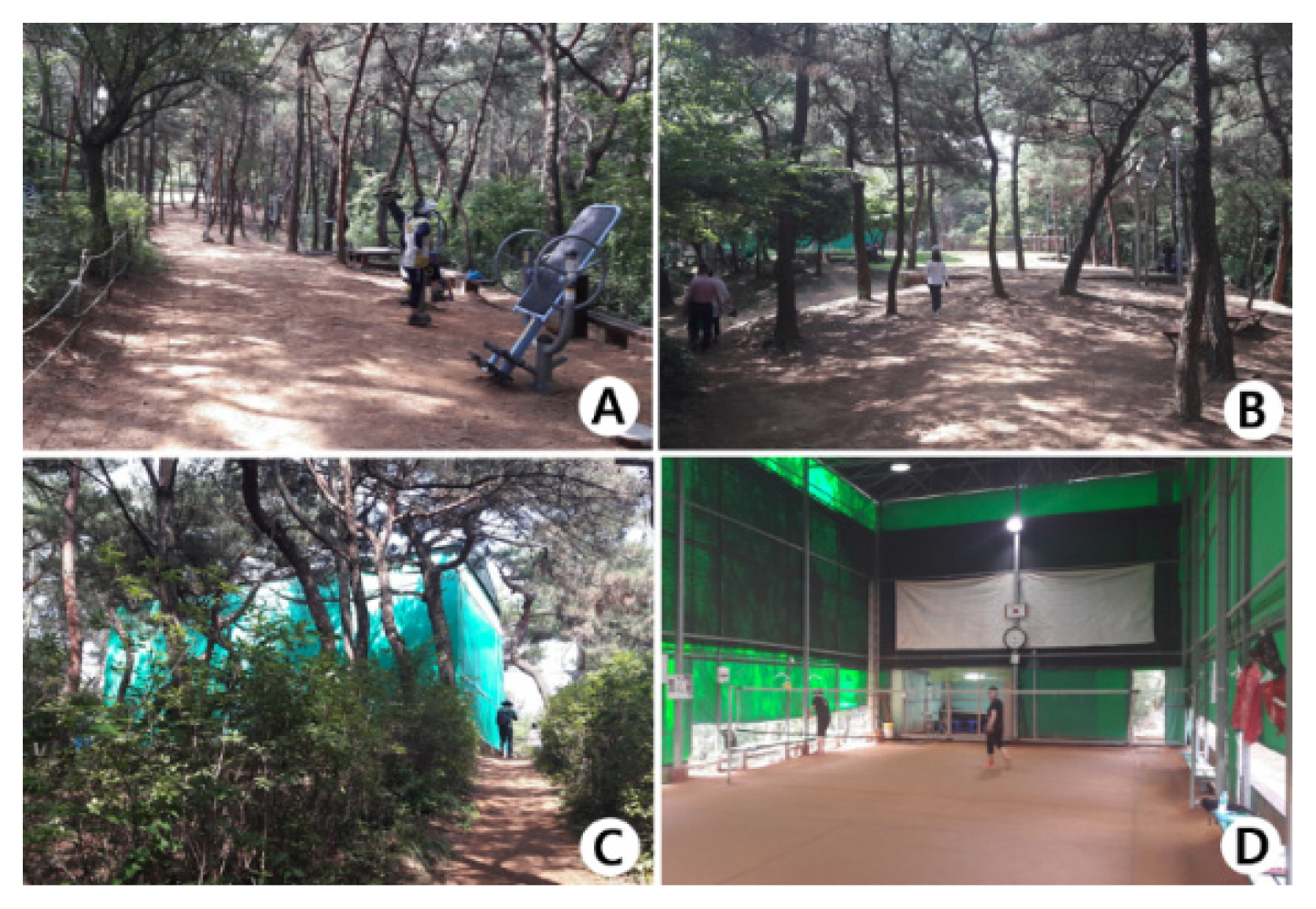
Fitness facilities (A), exercise ground with outdoor badminton court and fitness facilities (B), outside (C) and inside (D) of indoor badminton court, illegal temporary buildings constructed with steel frames and tents in Mt. Seonhaksan, Jinju City, South Korea.
Questionnaire design
Mountainous forests located in cities require an operation and management that integrate the use of recreational resources with the conservation of landscape and natural resources. Users of mountainous forests in Jinju City mostly visited for exercising and taking walks (Heo et al., 2016; Heo et al., 2017), and complaints are often raised about inappropriate facilities that had been built around forest trails of mountainous forests in the past. Therefore, we designed a questionnaire to evaluate the perception and satisfaction of users toward the use and landscape of forest trails and exercise facilities (Table 2). First, in order to analyze user characteristics, we included items about demographic background, behavior, and experience of users. Items on visit motives were composed by modifying and supplementing previous studies on arboretums, natural recreation forests, and urban forests (Heo et al., 2016; Heo et al., 2017; Joo and Yeo, 2000; Lee, 2012; Lim et al., 2008). In addition, items about users’ perception and satisfaction toward the use and landscape of forest trails and exercise facilities (outdoor fitness facilities and indoor badminton courts) as well as items about the needs for other facilities were included. Items on users’ characteristics were designed on a nominal scale, and the rest of the items were designed on a 5-point Likert scale (1 = very dissatisfied/strongly disagree to 5 = very satisfied/strongly agree).
Survey and analysis
The questionnaire-based survey was conducted on Jinju citizens who accepted it at the on-spot of each mountainous forest from September to October 2020 with a self-report questionnaire. Total 300 copies of the questionnaire were used in the analysis, excluding those with inappropriate responses. The data collected were analyzed using IBM SPSS Statistics 24. Frequency analysis was conducted on variables about users’ characteristics, and descriptive analysis was conducted on the rest. For variables about users’ perception and satisfaction, the overall satisfaction toward forest trails, outdoor fitness facilities, and indoor badminton courts was used as the dependent variable, while the rest were used as independent variables. Stepwise multiple regression analysis was conducted, and regression model equations with highest explanatory power were suggested (Lee and Lim, 2018).
Results and Discussion
Demographic background
There were more female (58.7%) than male participants (Table 3). Overall, the closer the recreational space was to the urban center and the better the accessibility, the more female visitors there were (Noh et al., 2010), which was consistent with the study results of Heo et al. (2017) who analyzed the use of urban mountainous forests in Jinju City in 2004 and 2017. The distribution of users by age was high in 51–60 and 61–70 years, which may be a tendency due to the easy accessibility of forests in the city center and monotonous recreational services such as hiking and walking (Heo et al., 2016; Heo et al., 2017; Kim, 2014; Lee, 2019). On the other hand, in the case of arboretums and natural recreation forests, which have relatively poor accessibility but have programs such as exhibitions and education, the frequency of those aged 31–40 and 41–50 was high (Joo and Yeo, 2000; Lee, 2012; Lim et al., 2008; Noh et al., 2010). By residence, there was highest frequency of users living 1–5km away from the entrance of the mountainous forest. Compared to the study by Heo et al. (2017), this result represents that the residential distribution of users has become wider, and the user distribution of urban mountainous forests is also regionally expanding, which implies that it is necessary to build or expand parking lots at the entrance of the mountainous forest.
Behaviors and visit motives
Regardless of weekdays or weekends, most users visited every day or 2–3 times a week at dawn or in the morning (Table 4). This trend is similar to the results of a previous study analyzing the use of urban mountainous forests in Jinju City, in which the number of daily visitors decreased and the number of visitors visiting 2–3 times a week increased in 2017 compared to 2004 (Heo et al., 2017). This may be due to the fact that, while recreational activities become relatively more diverse, the recreational programs available at Mt. Seonhaksan, Mt. Sukhosan, and Mt. Seokgapsan tend to be monotonous. For duration of stay, 1–2 hours showed the highest frequency. Lee and Yun (2009) stated that leisure activities of urban residents included exercising, using the computer, and watching TV on weekdays, and exercising, socializing, and traveling on weekends. They spend 2 hours on weekdays and 10 hours on weekends for leisure. Therefore, it is necessary to consider adopting various recreational programs to increase the duration of stay on weekends.

Behavior of users in Mt. Seonhaksan (A), Mt. Sukhosan (B), and Mt. Seokgapsan (C), Jinju City, South Korea
In Table 5, the frequency of Groups 1 and 2 with experience using outdoor fitness facilities was 69.0–78.9%, and the frequency of Groups 1 and 3 with experience using indoor badminton courts was 15.8–17.6%. The frequency of Group 4 who have no experience using either of the two facilities and use only forest trails was 17.9–28.0%. This indicates that most users are using outdoor fitness facilities around forest trails. Meanwhile, since there are users with different experiences, there could be diverse users’ perceptions on how exercise facilities such as outdoor fitness facilities and indoor badminton courts affect forest landscape and natural resources in urban mountainous forests like Mt. Seonhaksan, Mt. Sukhosan, and Mt. Seokgapsan.

Experience in using exercise and badminton facilities in Mt. Seonhaksan (A), Mt. Sukhosan (B), and Mt. Seokgapsan (C), Jinju City, South Korea
For visit motives, the frequency was highest in hiking or walking, followed by using outdoor fitness facilities and forest bathing and recreation with family (Table 6). This was different from the visit motives of botanical gardens, arboretums, and natural recreation forests providing exhibitions and education (Ballantyne et al., 2008; Joo and Yeo, 2000; Kim and Huh, 2016; Lee, 2012; Lim et al., 2008; Noh et al., 2010). As a result, this shows that Mt. Seonhaksan, Mt. Sukhosan, and Mt. Seokgapsan do not offer exhibitions and education, and the main purpose of visit among users is walking and fitness. Compared to the results of previous research analyzing the use of urban mountainous forests in Jinju City in 2004 and 2017 (Heo et al., 2017), the use of outdoor fitness facilities tended to increase, which may have been affected greatly by the restrictions on use of indoor fitness facilities due to COVID-19. Meanwhile, forest bathing became a more important visit motive in 2020 compared to 2004 in relation to healing or recovery, which shows that it is necessary to separately form and manage dynamic and static spaces in urban mountainous forests. Playing badminton, natural learning such as forest experience, and social gathering had means under 3 and thus were not common visit motives among citizens. However, considering the age distribution of users (Table 3), visit motives such as nature learning and social gathering may not have been sufficiently reflected due to the inadequacy of related facilities.
Satisfaction with trails
Satisfaction with the width of trails was 3.38–3.78, which can be considered relatively good (Table 7). On the other hand, satisfaction with the surface of trails was relatively low. Considering that 463 users visited Mt. Seonhaksan on weekdays as of 2016 (Heo et al., 2017), the results may be mainly caused by abrasion or erosion of the trail surface caused by the intensity of use exceeding the maintenance level. In particular, soil erosion was much more severe when there were exercise facilities set up around trails. Although some steep sections of trails have wooden decks installed or coconut mats laid out on slopes, maintenance and repair work must be conducted in a timely manner by monitoring the frequency of use and shorting the inspection cycle. Satisfaction with handrails, signs, etc. around trails was relatively good. As for satisfaction with the landscape and environment of outdoor fitness facilities, indoor badminton courts, and small private arable lands located around trails, satisfaction with outdoor fitness facilities was favorable, and indoor badminton courts showed near-average (3.0) satisfaction. Overall satisfaction was 3.74–3.93, showing the highest level.
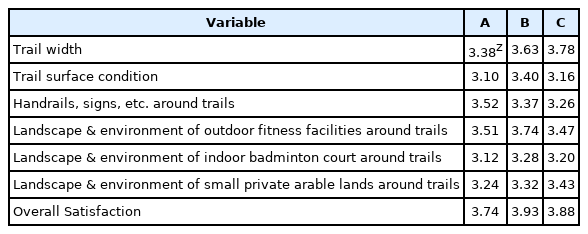
Satisfaction with forest trails in Mt. Seonhaksan (A), Mt. Sukhosan (B), and Mt. Seokgapsan (C), Jinju City, South Korea
As a result of conducting stepwise multiple regression analysis to identify the independent variables that have a significant effect on overall satisfaction (Table 8), the collinearity of each variable included first was not a problem since the tolerance was much greater than .10 (Lee and Lim, 2018; Park et al., 2022). For Mt. Seonhaksan, the R2 of the model was .440, indicating that the two independent variables are explaining 44% of the variance in overall satisfaction. For Mt. Sukhosan, the R2 of the model was .479, indicating that the three independent variables are explaining 48% of the variance in overall satisfaction. For Mt. Seokgapsan, the R2 of the model was .604, indicating that the four independent variables are explaining 60% of the variance in overall satisfaction. As a result of comprehensively evaluating the standardized coefficients Beta of the independent variables, the landscape and environment of small private arable lands had a significant effect on overall satisfaction, and the landscape and environment of fitness facilities and indoor badminton courts did not have a significant effect. This result shows that trail users engaged in complex recreational activities to enjoy the landscape and natural resources while exercising, such as hiking, walking, or physical fitness (Yoo et al., 2007), and that satisfaction of trail users was affected by not only the use of trails but also surrounding landscape. In South Korea, field crops are often cultivated in urban mountainous forests. Jinju City Hall continues to purchase and restore private lands in mountainous forests, but the small private arable lands that still remain around trails are perceived by users as poor landscape. Handrails and signs showed a significant effect on overall satisfaction, indicating that it is necessary to enhance maintenance and repair of facilities, and improve the designs. In particular, signs must be improved and changed rather than added so that they are easy-to-understand, detailed, and accurate for users (Noh et al., 2010). The width and surface of trails also showed a significant effect on overall satisfaction, indicating that it is necessary to continuously improve the maintenance level.
Satisfaction with outdoor fitness facilities
Safety in use, maintenance, and cleanliness of outdoor fitness facilities were rated as satisfied in Mt. Seonhaksan, Mt. Sukhosan, and Mt. Seokgapsan (Table 9). Urban mountainous forests in South Korea have excellent security, and fitness facilities are regularly maintained with only the qualified and standardized products set up on site, which is why reliability and safety were rated highly in relation to fitness. Moreover, with the use of indoor fitness facilities restricted due to COVID-19, outdoor fitness facilities were considered relatively safer against infection. Harmony with forest landscape was also rated as satisfied, and users perceived that there is no damage to landscape and natural resources. These results are consistent with the result of satisfaction with the landscape and environment of outdoor fitness facilities around trails (Table 7). Overall satisfaction was relatively low in Mt. Seonhaksan, but it was higher than 3.5 and thus satisfactory in Mt. Sukhosan and Mt. Seokgapsan.
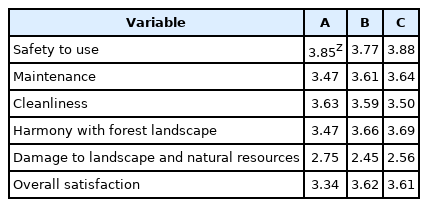
Satisfaction with outdoor fitness facilities in Mt. Seonhaksan (A), Mt. Sukhosan (B), and Mt. Seokgapsan (C), Jinju City, South Korea
In Table 10, the collinearity of each independent variable was not a problem since the tolerance was much higher than .10 (Lee and Lim, 2018; Park et al., 2022). Harmony with forest landscape and maintenance had a significant effect on overall satisfaction in Mt. Seonhaksan and Mt. Sukhosan, whereas maintenance, harmony with forest landscape, and safety in use had a significant effect in Mt. Seokgapsan. As a result of comprehensively evaluating the standardized coefficients Beta, harmony between outdoor fitness facilities and forest landscape was clearly significant factor for improvement of overall satisfaction. The next important factors were maintenance and safety in use.
Satisfaction with indoor badminton courts
Satisfaction with safety in use, maintenance, and cleanliness of indoor badminton courts, which are illegal temporary buildings made of steel frames and tents, was low compared to satisfaction with fitness facilities (Table 11). Satisfaction with harmony with forest landscape was average at 3.01 in Mt. Seonhaksan and lower than 3.00 in Mt. Sukhosan and Mt. Seokgapsan. This shows that the exterior or surroundings of indoor badminton courts provide an unsatisfying landscape to users of trails and fitness areas. In this regard, regarding the question of whether the indoor badminton courts damage the landscape and natural resources, in the case of Mt. Seonhak and Mt. Sukho, 3.11 and 3.00, respectively, were perceived as above average. Overall satisfaction was 3.01–3.08, which was very low compared to satisfaction with trails or outdoor fitness facilities. As a result of additionally analyzing overall satisfaction of non-users with indoor badminton courts, the satisfaction levels were lower than average (dissatisfied) at 2.92 in Mt. Sukhosan and 2.83 in Mt. Seokgapsan.
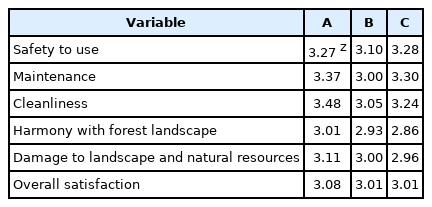
Satisfaction with indoor badminton courts in Mt. Seonhaksan (A), Mt. Sukhosan (B), and Mt. Seokgapsan (C), Jinju City, South Korea
In Table 12, the collinearity of the independent variables was not a problem since the tolerance was much higher than .10 (Lee and Lim, 2018; Park et al., 2022). All regression models in which R2 values were calculated as .551-.750 showed high explanatory power. As a result of evaluating the standardized coefficients Beta of the independent variables, harmony with forest landscape clearly had a significant effect on overall satisfaction, and cleanliness, maintenance, and safety in use also had a significant effect. This result was similar to that of outdoor fitness facilities (Table 10).
Enhancement of satisfaction with forest trails and exercise facilities
As a result of analyzing the current status, visit motives, and behaviors in Mt. Seonhaksan, Mt. Sukhosan, and Mt. Seokgapsan, recreational activities provided by the three urban mountainous forests were hiking or walking, fitness, and badminton (Table 6), and the key factors affecting satisfaction were forest trails and exercise facilities, but not badminton (Tables 7, 9). In improving forest trails, it is important to maintain and repair the width and surface of forest trails, but what may be more important is to renovate the landscape and environment of small private arable lands and exercise facilities. Small arable lands can be easily restored when illegal, but most are privately owned by individuals and thus restoration is not easy. On the other hand, outdoor fitness facilities and indoor badminton courts can be relatively easily renovated by Jinju City Hall. It is necessary to identify the forest landscape and functional types preferred by users who visit these areas for hiking and walking while avoiding monotonous forest landscapes (Yoo et al., 2007) and consider creating a woodland garden with the concept of wild gardens. It is also necessary to continuously analyze users’ perceptions toward different unsatisfying landscapes around forest trails and establish and implement maintenance plans accordingly.
In Tables 10 and 12, satisfaction with outdoor fitness facilities and indoor badminton courts was affected significantly by harmony with forest landscape. As a result of analyzing the responses to the question about the need to relocate or improve and maintain exercise facilities (Table 13), there was a high perception that outdoor fitness facilities must be improved and maintained without being relocated. Therefore, considering the visit motives, harmony with forest landscape, and satisfaction, it is desirable to improve and maintain outdoor fitness facilities. As for indoor badminton courts, there were unclear perceptions toward the need to relocate or improve and maintain. However, considering the number of users for indoor badminton courts, visit motives, harmony with forest landscape, and satisfaction, it is desirable to relocate indoor badminton courts to the outskirts or boundaries of urban mountainous forests.

Users’ recognition of the need to relocate or to improve and maintain exercise facilities in Mt. Seonhaksan (A), Mt. Sukhosan (B), and Mt. Seokgapsan (C), Jinju City, South Korea
In urban forests, traditional recreational activities such as hiking and appreciating landscapes are most commonly found, followed by using pavilions and benches and participating in nature education activities through forest interpreters and programs (Yoo et al., 2007). Typical recreational activities that can be done in natural recreational forests are walking and forest bathing in the forest, and recently various leisure sports are also adopted, including mind and body training by observing nature and visiting the forest, and mediating in the forest (Heo et al., 2016; Joo and Yeo, 2000). The key activities of the three mountainous forests located in Jinju City were hiking or walking, fitness, and badminton (Table 6) and thus more diverse leisure and recreational activities must be provided considering the recent lifestyles of urban residents. As a result of analyzing the perceptions toward the need for facilities other than forest trails and exercise facilities (Table 14), the need to create a forest bathing place was highest at 3.58–3.83, followed by the need to create a family recreation place at 3.39–3.53. The need to create an outdoor learning classroom was relatively low at 3.31–3.49, which may be due to the age distribution of users. As more and more family visitors are visiting forests that are located nearby, the percentage of women in their 30s and 40s interested in nature learning with children is also increasing, which raises the need to establish recreational facilities and learning spaces that can satisfy these users (Lee, 2012).
Conclusion
Urban mountainous forests are places of leisure and recreation for urban residents with landscape and natural resources. The revitalization of sports for all increases users of not only urban parks but also trails and exercise facilities in urban mountainous forests nationwide. This study assessed users’ perceptions and satisfaction toward forest trails and exercise facilities (outdoor fitness facilities and indoor badminton courts) in urban mountainous forests of Jinju City, Gyeongnam.
There was a higher percentage of female than male users and a high percentage of users aged 51 or older. Most users visited every day or 2–3 times a week regardless of weekday or weekend and stayed for 1–2 hours. They used forest trails along with outdoor fitness facilities around. Hiking or walking showed the highest frequency in visit motives, followed by the use of outdoor fitness facilities and forest bathing & recreation with family. Overall satisfaction with trails was high at 3.74–3.93. There was also high satisfaction with trail width, amenities such as handrails and signs, and the landscape and environment of outdoor fitness facilities around forest trails. Variables that significantly affected overall satisfaction with trails were the landscape and environment of small private arable lands and the amenities such as handrails and signs around forest trails. Overall satisfaction with outdoor fitness facilities was relatively high at 3.34–3.62, and there was high satisfaction with safe to use, maintenance, and cleanliness of outdoor fitness facilities. Variables that significantly affected overall satisfaction with outdoor fitness facilities were harmony with forest landscape and maintenance. Overall satisfaction with indoor badminton courts was lower at 3.01–3.08 compared to forest trails or outdoor fitness facilities, resulting from less harmony with the forest landscape. Satisfaction with harmony between indoor badminton courts and forest landscape was low at 2.86–3.01. As a result, satisfaction with outdoor fitness facilities and indoor badminton courts was significantly affected by harmony with the forest landscape.
It is crucial to maintain and repair the width and surface of forest trails, but renovating the landscape and environment of small private arable lands and exercise facilities may be more critical. Therefore, it is necessary to identify the forest landscape and functional types preferred by users, consider creating woodland gardens and establish and implement maintenance plans by constantly analyzing users’ perceptions of unsatisfying landscapes around forest trails. According to the results of this study, it is desirable to improve and maintain outdoor fitness facilities and relocate indoor badminton courts to the outskirts or boundaries of the mountainous forests. In addition, to provide various leisure and recreation activities in consideration of the lifestyles of city residents, the creation of a forest bathing place will be first necessary, followed by the design of a family recreation place and outdoor learning classroom.
Notes
This research has been modified and supplemented with the results of academic research conducted with financial support from Jinju City.








